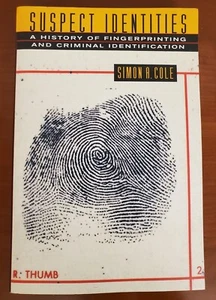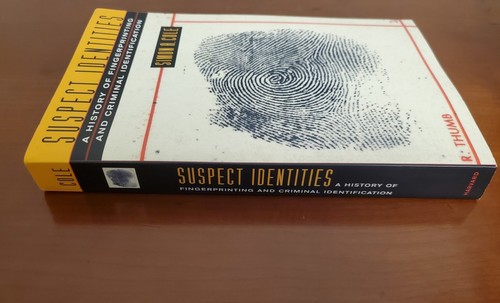Imagen 1 de 3



Galería
Imagen 1 de 3



¿Quieres vender uno?
Suspect Identities : A History of Fingerprinting and Criminal Identification
USD6,00
Aproximadamente5,16 EUR
o Mejor oferta
Estado:
Oops! Looks like we're having trouble connecting to our server.
Refresh your browser window to try again.
Envío:
USD5,22 (aprox. 4,49 EUR) USPS Media MailTM.
Ubicado en: Forest Hills, New York, Estados Unidos
Entrega:
Entrega prevista entre el mié. 29 oct. y el lun. 3 nov. a 94104
Devoluciones:
No se aceptan devoluciones.
Pagos:
Compra con confianza
El vendedor asume toda la responsabilidad de este anuncio.
N.º de artículo de eBay:227032495229
Características del artículo
- Estado
- ISBN
- 9780674010024
Acerca de este producto
Product Identifiers
Publisher
Harvard University Press
ISBN-10
0674010027
ISBN-13
9780674010024
eBay Product ID (ePID)
2298569
Product Key Features
Book Title
Suspect Identities : a History of Fingerprinting and Criminal Identification
Number of Pages
400 Pages
Language
English
Topic
Forensic Science, Criminology
Publication Year
2002
Illustrator
Yes
Features
Reprint
Genre
Law, Social Science
Format
Trade Paperback
Dimensions
Item Height
1 in
Item Weight
13 Oz
Item Length
9.2 in
Item Width
6.1 in
Additional Product Features
Intended Audience
Trade
Reviews
Cole's comprehensive...book investigates the tangled intersections of scientific identification and law enforcement...[with] rigorous detail and attention to historical ambiguities...This well-wrought history will be admired by scholars and serious lay readers., Cole's Suspect Identities is far more than a masterly and detailed chronicle of the journey from the anonymous mobile stranger in the seventeenth century to today's DNA-fingerprinted sex offender whose moves are tracked via the Internet. It is also an astute analysis of the social, political, and economic forces that explain why the journey took certain paths. This book sets the high benchmark for scholarship in this area., Suspect Identities is a fascinating account of an important subject. In his history of identification techniques from fingerprints to DNA, Simon Cole tells the story of our recurring attempts to forge reliable links between bodies, persons, and crimes. As Cole shows in these pages, the aim of these techniques, from Martin Guerre to O. J. Simpson, is not just to link persons with criminal acts. It is to link persons to themselves, to establish their identities with the certainty of science, and to use these identifiers for bureaucratic and diagnostic purposes. And therein lies their danger, as well as their usefulness, as critics of 'DNA fingerprinting' are beginning to discover. Written with intelligence, wit, and insight, this book will stand as the definitive account for a long time to come., Suspect Identities shows that a fascinating journey through the history of science can illuminate current controversies. This well-written book teaches us as much about the problems facing forensic scientists today as it does the history of fingerprinting., For almost a century, fingerprinting remained one of the most respected tools of forensic science. Only in the early nineties did faith in its reliability begin to erode. In [Suspect Identities], Simon A. Cole recounts how a number of cases involving the New York State Police revealed tampering with fingerprint evidence, as well as the incompetence of many police labs., For almost a century, fingerprinting remained one of the most respected tools of forensic science. Only in the early nineties did faith in its reliability begin to erode. In [ Suspect Identities ], Simon A. Colerecounts how a number of cases involving the New York State Police revealed tampering with fingerprint evidence, as well as the incompetence of many police labs., Cole's treatment of fingerprinting is...commendable...[He] shows that...court cases...were not quite as singular in ascendancy of fingerprinting over the Bertillon system, but rather added weights that finally tipped the scales in favor of fingerprinting; he is also cautionary about its claim to absolute reliability., Cole weaves the intriguing tale of how and why people were identified as who they claimed to be. This history begins in the era where identification was largely unnecessary because people did not travel very far and were known in their own communities. As both travel and criminal behavior increased, the need to identify people grew...Cole describes the ancient use of fingerprints up through time until they became commonplace for use in identifying criminals. He presents an excellent account of the problems and controversies surrounding the use of fingerprints for identification, ending with the current issues of using DNA for identification. The illustrative stories are excellent, making this a fascinating trip through identification history., Simon A. Cole's well-written and interesting book is a cultural, social, and scientific history of fingerprint identification. It makes the intriguing argument that scientific merit had nothing to do with the acceptance of fingerprints as uniquely good identification evidence., For most of the century since it made its courtroom debut, fingerprinting has enjoyed an impeccable reputation for identifying criminals. What jury would acquit a suspect if his prints matched those found at the scene of a crime'...Simon Cole...is one of a small group of people that has started looking at the technique which, above all others, gave forensic 'science' its scientific status. And, surprisingly, he has found it is scientifically and statistically wanting.
Dewey Edition
21
Dewey Decimal
363.25/8
Table Of Content
Prologue: Jekylls and Hydes 1. Impostors and Incorrigible Rogues 2. Measuring the Criminal Body 3. Native Prints 4. Degenerate Fingerprints 5. Fingerprinting Foreigners 6. From Anthropometry to Dactyloscopy 7. Bloody Fingerprints and Brazen Experts 8. Dazzling Demonstrations and Easy Assumptions 9. Identification at a Distance 10. Digital Digits 11. Fraud, Fabrication, and False Positives 12. The Genetic Age Epilogue: Bodily Identities Notes Credits Acknowledgments Index
Edition Description
Reprint
Synopsis
"No two fingerprints are alike," or so it goes. For nearly a hundred years fingerprints have represented definitive proof of individual identity in our society. We trust them to tell us who committed a crime, whether a criminal record exists, and how to resolve questions of disputed identity. But in Suspect Identities , Simon Cole reveals that the history of criminal identification is far murkier than we have been led to believe. Cole traces the modern system of fingerprint identification to the nineteenth-century bureaucratic state, and its desire to track and control increasingly mobile, diverse populations whose race or ethnicity made them suspect in the eyes of authorities. In an intriguing history that traverses the globe, taking us to India, Argentina, France, England, and the United States, Cole excavates the forgotten history of criminal identification--from photography to exotic anthropometric systems based on measuring body parts, from fingerprinting to DNA typing. He reveals how fingerprinting ultimately won the trust of the public and the law only after a long battle against rival identification systems. As we rush headlong into the era of genetic identification, and as fingerprint errors are being exposed, this history uncovers the fascinating interplay of our elusive individuality, police and state power, and the quest for scientific certainty. Suspect Identities offers a necessary corrective to blind faith in the infallibility of technology, and a compelling look at its role in defining each of us., Cole excavates the forgotten global history of criminal identification--from photography to exotic anthropometric systems based on measuring body parts, from fingerprinting to DNA typing. He reveals how fingerprinting ultimately won the trust of the public and the law after a long battle against rival identification systems.
LC Classification Number
HV6074
Descripción del artículo del vendedor
Acerca de este vendedor
Quality_goodz-718
99,3% de votos positivos•4,4 mil artículos vendidos
Registrado como vendedor particularPor tanto, no se aplican los derechos de los consumidores derivados de las leyes de protección de los consumidores de la UE. La Garantía al cliente de eBay sigue aplicando a la mayoría de compras. Más informaciónMás información
Votos de vendedor (2.016)
- 3***p (115)- Votos emitidos por el comprador.Últimos 6 mesesCompra verificadaGreat working with seller. I received the items as they were described. Seller packaged items professionally and they were shipped an received very timely. If the opportunity presents itself, I would work with this seller again.
- r***n (1966)- Votos emitidos por el comprador.Mes pasadoCompra verificadaVery, very fast very very happy thank you very much. Great packaging for shipping as described in a great value. Hope to do business with you again sometime soon soon thanks again again. ⭐️⭐️⭐️⭐️⭐️👍😊🤗
- 8***8 (681)- Votos emitidos por el comprador.Mes pasadoCompra verificadaA+ Seller! Unique products at a reasonable price. Items were in good condition, accurately described, packaged securely, and promptly mailed. Highly recommend! Thank you!

